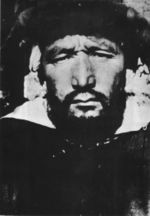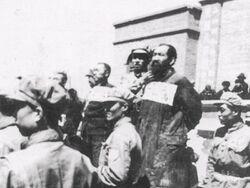عثمان باتور
عثمان باتور (إسلامولي) | |||||||
|---|---|---|---|---|---|---|---|
 | |||||||
| الاسم المحلي | Osman Batyr (Islamuly) | ||||||
| ولد | 1899 ناحية كوكتوقاي، محافظة ألطاي، شينجيانگ | ||||||
| توفي | أبريل 29, 1951 أورومچي، شينجيانگ | ||||||
| الولاء | |||||||
| المعارك/الحروب | |||||||
| |||||||
| عثمان باتور | |||||||||
|---|---|---|---|---|---|---|---|---|---|
| Chinese name | |||||||||
| الصينية التقليدية | 烏斯滿·巴圖爾 | ||||||||
| الحروف المبسطة | 乌斯满·巴图尔 | ||||||||
| |||||||||
| Mongolian name | |||||||||
| Mongolian Cyrillic | Осман дээрэмчин | ||||||||
| Mongolian script | ᠣᠰᠮᠠᠨ ᠳᠡᢉᠡᠷᠡᠮᠴᠢᠨ | ||||||||
| قزخ name | |||||||||
| قزخ | وسپان باتىر Оспан батыр Ospan Batyr | ||||||||
عثمان باتور (بالقزخية: Оспан батыр؛ Ospan batır؛ وسپان باتىر؛ الصينية: 烏斯滿·巴圖爾؛ إنگليزية: Osman Batyr؛ وأحياناً تُكتب Uthmān/Osman Bātūr, Osman Batir أو Osman Batur)[1] (1899 - 29 أبريل 1951)، ابن إسلامباي، وُلِد في ناحية كوكتوقاي، محافظة ألطاي، شينجيانگ، الصين. عمِل في بادئ الأمر لدى جمهورية تركستان الشرقية الثانية الأويغورية الشيوعية المناصرة للسوڤيت ولدى جمهورية منغوليا الشعبية أثناء تمرد إيلي، إلا أنه انقلب و فر إلى جيش الكومنتانگ (جمهورية الصين). ثم قاتل ضد المنغول وضد الاتحاد السوڤيتي أثناء حادث پـِيْ-تا-شان (بايتاگ بوگد).
في شينجيانگ، قاد شعب القزخ لقتال الشيوعيين. وقد أُسِر في هامي (شرق شينجيانگ)، وأُعدِم في أورومچي في 29 أبريل 1951، بعد مقاومة استيلاء الشيوعيين على شينجيانگ. وبعد وفاته، فر العديد من أتباعه عبر جبال الهيمالايا. وبعد ذلك نقلتهم جهة ما (؟) إلى إيطاليا، حيث يعيشون حتى الآن، هم ونسلهم.
السيرة
Batur was born in 1899 at Öngdirkara in the Köktogay region of Altay (Koktokay County, Altay Prefecture, Xinjiang, China) as Osman Islamuly. "Batur" is an honorific title that means 'brave'. He was the son of İslâm Bey, a middle-class farmer of the Altay Kazakhs.
Some sources note that Osman Batur was considered a good rider and a master hunter before the age of 10 and learned martial arts from Böke Batur, a Kazakh whose service he entered at 12.[2] However, other works have noted that Osman would have been four years old at the time in question, so these stories may be an attempt to give him a "heroic upbringing".[3]
In 1940, as the Chinese administration increased the pressure, Osman took his gun and went to the mountain alone.
Osman began his struggle against the Chinese and Russians in 1941, aiming to liberate all Altai lands and East Turkestan from the Chinese and Russians. In World War II, with increasing pressure on the Turks in East Turkestan, the reaction movements gained strength and prepared the ground for the rise of Osman Batur.
Osman Batur, who started to clean the Altays from the Chinese, reached his goal in 1943. In a ceremony held in Bulgun on July 22, 1943, the inn [clarification needed] of Osman Batur Altay Kazakhs was declared. By 1945, the Turks had taken control except for a few cities in East Turkestan. When the situation became intolerable and dangerous for the Chinese, their armies conducted harsh and intense regional operations. Although Osman Batur, who was removed from Targabatay and Altays, had started the fight with thirty thousand people, by 1950, this number was approximately four thousand. There was also a struggle between Alibek Hakim and his comrades.
In Xinjiang, he led the Kazakh people to fight against PRC. He was captured in Hami (Eastern Xinjiang), circulated, and executed in Urumqi on April 29, 1951, and his hands and feet were cut off. His children were captured, tortured, and killed by the Chinese, and his wife lost her mind and drowned herself. After his death, many of his followers fled over the Himalayas. Afterwards, they were airlifted to Turkey and resettled there.[بحاجة لمصدر].
النزاع في بايتاگ بوگد
The East Turkestan Republic was not united. There was a split in the government, and two groups fought. The leaders of individual districts and units showed separatism, notably one of the most striking "field commanders" of Ospan-Batyr (Osman-Batyr) of Islam. In the 1930s, he was a little-known gang leader. In 1940, Ospan became one of the leaders of the Kazakh uprising in the Altai district against Governor General Sheng Shitsai. The rebellion was caused by the decision of the authorities to transfer the pastures and watering places to the settled peasants – Dungans and Chinese. In 1943, Altai Kazakhs rebelled again due to the decision of the authorities to relocate them to the south of Xinjiang and place Chinese refugees in their nomadic lands. After Ospan met with Choibalsan, leader of the Mongolian People's Republic, weapons rebels supplied the MPR. In the spring of 1944, Osman Batyr was forced to retreat to Mongolia.
Moreover, his unit's departure was covered by the air forces of the MPR and the USSR. In the fall of 1945, the Osman-Batyr detachment liberated the Altai District from the Kuomintang. After that, Ospan-Batyr was appointed by the government of the WTR Governor of the Altai District.
Disputes immediately began between him and the WTR government. The Altai governor refused to comply with the instructions of the republic's leadership, and his troops did not obey the army's command. In particular, when the WTR army suspended military operations against the Kuomintang troops (the WTR leadership accepted the proposal to start negotiations to create a single coalition government in Xinjiang), the Ospan-Batyr detachments not only failed to comply with this instruction but, on the contrary, intensified their activities. At the same time, his gangs were smashed and plundered by the Kuomintang units and wagons and the villages controlled by the VTR. It was not for nothing that Stalin called the Ospan-Batyr "a social bandit."
Ospan hatched plans to create the Altai Khanate, utterly independent of the WTR and China, hoping for support from Mongolia. This caused concern for Moscow. The head of the NKVD, Beria, turned to Molotov with a request to coordinate actions against this Kazakh Robin Hood with Marshal MPR Choibalsan. However, attempts by the command of the army and the leadership of the WTR, Soviet representatives, and personally Choibalsan to reason the rebellious commander failed. In 1946, referring to the disease, he left the post of governor and returned to the free life of the "field commander". They robbed the settlements that were part of the WTR.
At the end of 1946, Ospan took the side of the Kuomintang authorities and received the post of a specially authorized Xinjiang government in the Altai District. He became one of the most dangerous enemies of the WTR and the MPR. At the beginning of June 1947, a detachment of Ospan-Batyr of several hundred fighters, with the support of Kuomintang army units, invaded the territory of Mongolia in the Baitag-Bogd region. Ospan's bandits destroyed the border outpost and invaded the depths of the MPR. On June 5, Mongol troops approached with the support of Soviet aviation and knocked out the enemy. Then the Mongols invaded Xinjiang but were defeated in the area of the Chinese outpost of Betashan. Subsequently, both sides exchanged several raids; skirmishes continued until the summer of 1948. After the Baitag-Bogd incident, Beijing and Moscow exchanged notes with mutual accusations and protests.
Ospan remained on the side of the Kuomintang government, received reinforcements by people, weapons, and ammunition, and in the fall of 1947, fought in the Altai District with the troops of the World Trade Organization. He was even able to capture the capital of Shara-Sume County temporarily. The authorities of the republic had to carry out additional mobilization. Soon, Ospan-Batyr was defeated and fled east. In 1949, the Kuomintang in China was defeated. The Communists defeated and occupied Xinjiang. Ospan rebelled against the new government. In 1951, the rebellious leader was caught and executed.
إعدامه
لحظة إعدام القائد المسلم "عثمان باتور "من قبل السلطات الصينية بعد 11 عام من النضال والقتال من أجل تحرير تركستان الشرقية من الاحتلال الصيني الشيوعي.
تم أسره بعد خيانته فسُجن وأعدم ومثل بجثته وقطعت أنفه وأذنه وهو يصدح بالتكبير والتهليل بعد رفضه دعوة اتباعه وقف القتال.
وصل خبر استشهاده لأمه فقالت: "إنما ربيت ولدي لمثل هذا"
انظر أيضاً
المصادر
- ^ Hsiao-ting Lin (2010). Modern China's ethnic frontiers: a journey to the west. Vol. Volume 67 of Routledge studies in the modern history of Asia (illustrated ed.). Taylor & Francis. p. 126. ISBN 0-415-58264-4. Retrieved 2011-12-27.
Osman Bator 烏斯滿
{{cite book}}:|volume=has extra text (help) - ^ Lias, Godfrey (1956). Kazak Exodus (in الإنجليزية). Evans Bros.
- ^ Jacobs, Justin (December 2010). "The Many Deaths of a Kazak Unaligned: Osman Batur, Chinese Decolonization, and the Nationalization of a Nomad". The American Historical Review. 115 (5): 1291–1314. doi:10.1086/ahr.115.5.1291. ISSN 0002-8762. S2CID 163488929.
- Godfrey Lias, Kazak Exodus, London: Evan Brothers Limited (1956)
- Justin Jacobs, "The many deaths of a Kazak unaligned", American Historical Review 115.5 (2010), pp.1291-1314
- Linda K. Benson and Ingvar Svanberg, China's Last Nomads: The History and Culture of China's Kazaks, New York: M.E. Sharpe (1998), pp.72-87
- Halife Altay, Anayurttan Anadoluʹya, Ankara: Kültür Bakanlığı, 1981 (Turkish)
- Halife Altay, Kazak Türklerine aid şecere, Istanbul, 1997 (Turkish)
- Gülçin Çandarlıoğlu, Özgürlük Yolu, Nurgocay Batur'un Anılarıyla Osman Batur, Istanbul: Doğu Kütüphanesi, 2006 (Turkish)
- Zordun Sabir, Anayurt, Almaty: Nash Mir, 2006 (Uyghur)
- Hızır Bek Gayretullah, Osman Batur, (Turkish)
- Hızır Bek Gayretullah, Altaylarda Kanlı Günler, 1977 (Turkish)
- CS1 errors: extra text: volume
- Short description is different from Wikidata
- Articles containing صينية-language text
- Articles containing منغولية-language text
- Articles containing قزخ-language text
- Articles containing traditional Chinese-language text
- Articles containing إنگليزية-language text
- Pages using Lang-xx templates
- مقالات ذات عبارات بحاجة لمصادر
- مواليد 1899
- وفيات 1951
- مسلمون صينيون
- Chinese military personnel
- الإسلام في الصين
- Ethnic Kazakh people
- أشخاص من محافظة ألطاي
- اعدامات في القرن العشرين قامت بها الصين
- مؤمنون بالوحدة التوركية
- قزخ في الصين
- صينيون من أصل قزخستاني
- معدمون من شينجيانگ
- معدمون من جمهورية الصين
- Executed Republic of China people
- People executed by China by firing squad

